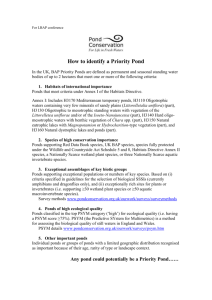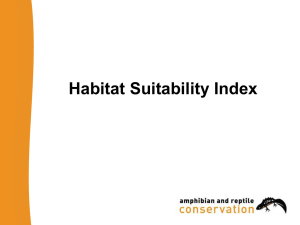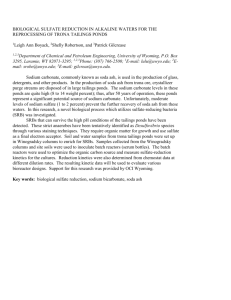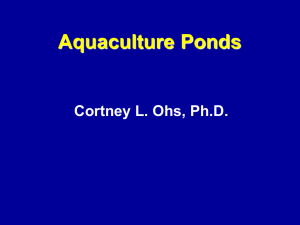Ponds - JNCC
advertisement
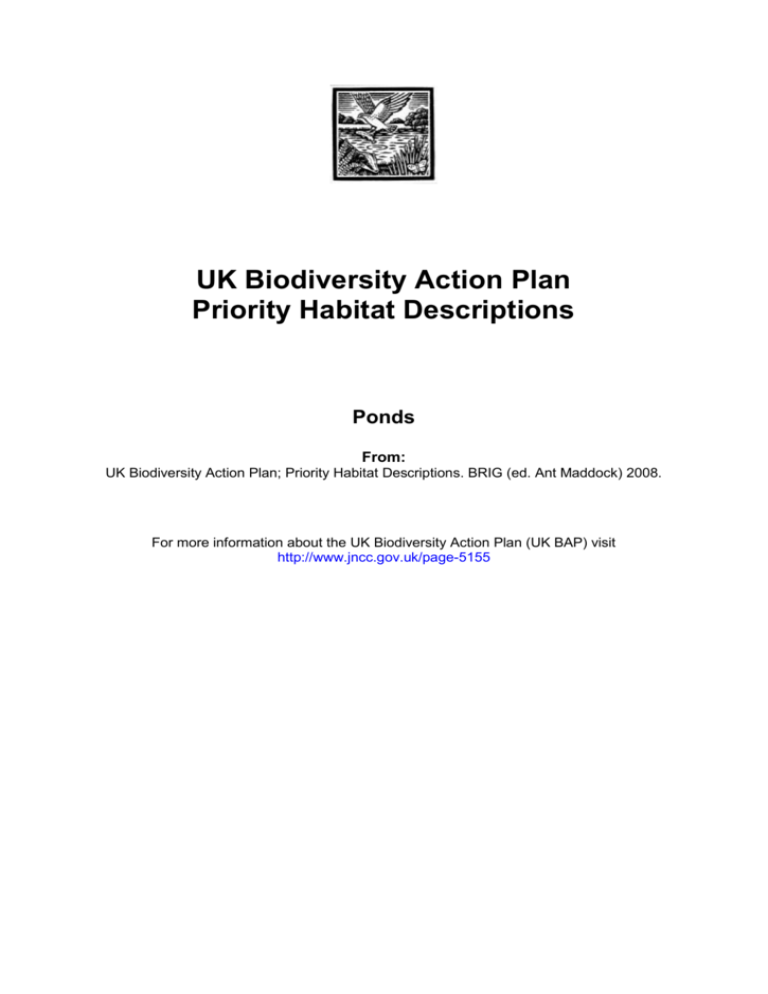
UK Biodiversity Action Plan Priority Habitat Descriptions Ponds From: UK Biodiversity Action Plan; Priority Habitat Descriptions. BRIG (ed. Ant Maddock) 2008. For more information about the UK Biodiversity Action Plan (UK BAP) visit http://www.jncc.gov.uk/page-5155 Ponds Correspondence with existing habitat/s UK BAP broad habitat: Standing open waters and canals Phase 1: G1 Standing water NVC: Various aquatic, swamp and fen communities; OV28-OV35; and others Annex I: Includes H3170 Mediterranean temporary ponds; H3110 Oligotrophic waters containing very few minerals of sandy plains (Littorelletalia uniflora) (part); H3130 Oligotrophic to mesotrophic standing waters with vegetation of the Littorelletea uniflorae and/or of the IsoetoNanojuncetea (part); H3140 Hard oligo-mesotrophic waters with benthic vegetation of Chara spp. (part); H3150 Natural eutrophic lakes with Magnopotamion or Hydrocharition-type vegetation (part); and H3160 Natural dystrophic lakes and ponds (part) Description Ponds, for the purpose of UK BAP priority habitat classification, are defined as permanent and seasonal standing water bodies up to 2 ha in extent which meet one or more of the following criteria: Habitats of international importance: Ponds that meet criteria under Annex I of the Habitats Directive. Species of high conservation importance: Ponds supporting Red Data Book species, UK BAP species, species fully protected under the Wildlife and Countryside Act Schedule 5 and 8, Habitats Directive Annex II species, a Nationally Scarce wetland plant species, or three Nationally Scarce aquatic invertebrate species. Exceptional assemblages of key biotic groups: Ponds supporting exceptional populations or numbers of key species. Based on (i) criteria specified in guidelines for the selection of biological SSSIs (currently amphibians and dragonflies only), and (ii) exceptionally rich sites for plants or invertebrates (i.e. supporting ≥30 wetland plant species or ≥50 aquatic macroinvertebrate species). Ponds of high ecological quality: Ponds classified in the top PSYM category (“high”) for ecological quality (i.e. having a PSYM score ≥75%). [PSYM (the Predictive SYstem for Multimetrics) is a method for assessing the biological quality of still waters in England and Wales; plant species and / or invertebrate families are surveyed using a standard method; the PSYM model makes predictions for the site based on environmental data and using a minimally impaired pond dataset; comparison of the prediction and observed data gives a % score for ponds quality]. Other important ponds: Individual ponds or groups of ponds with a limited geographic distribution recognised as important because of their age, rarity of type or landscape context e.g. pingos, duneslack ponds, machair ponds. Priority habitat ponds can be readily identified by standard survey techniques such as those developed for NVC, Common Standards Monitoring, the National Pond Survey or for specific species groups. Ponds will need to be distinguished from other existing priority habitat types. The general principle to be applied is that where the standing water element is functionally a component of another priority habitat and that priority habitat definition takes account of the standing water element then it should be treated as part of that habitat. For example small waterbodies within blanket bog should be considered as part of the blanket bog priority habitat, but ponds in heathland (which are not dealt with through the heathland HAP) should be considered under the pond priority habitat. Agreement has been reached with the lake HAP group that the pond priority habitat will cover most water bodies up to 2 ha while the lake priority habitat will cover most water bodies greater than 2ha. As with other potentially overlapping priority habitat types a small proportion of cases will need to be individually assessed to decide how they are best dealt with. Ponds are widespread throughout the UK, but high-quality examples are now highly localised, especially in the lowlands. In certain areas high quality ponds form particularly significant elements of the landscape, e.g. Cheshire Plan marl pits, the New Forest ponds, pingos of East Anglia, mid-Wales mawn pools, the North East Wales pond landscape, the forest and moorland pools of Speyside, dune slack pools, the machair pools in the Western Isles of Scotland, and examples of Habitats Directive Annex I pond habitats across Northern Ireland. Estimates, based on the relatively small pond data sets currently available, suggest that around 20% of the c.400,000 ponds outside curtilage in the UK might meet one or more of the above criteria. An inventory of ponds, including many high quality sites, has been established as part of the National Pond Monitoring Network and work is in progress to add further known sites to this database. This is publicly accessible (for non-sensitive sites/species) at www.pondnetwork.org.uk. Currently about 500 high quality sites are listed on this database. The National Pond Monitoring Network (NPMN) will provide the main mechanism for monitoring priority habitat ponds. The NPMN was established in 2002 as a partnership of organisations involved in pond monitoring led by the Environment Agency and Pond Conservation.

